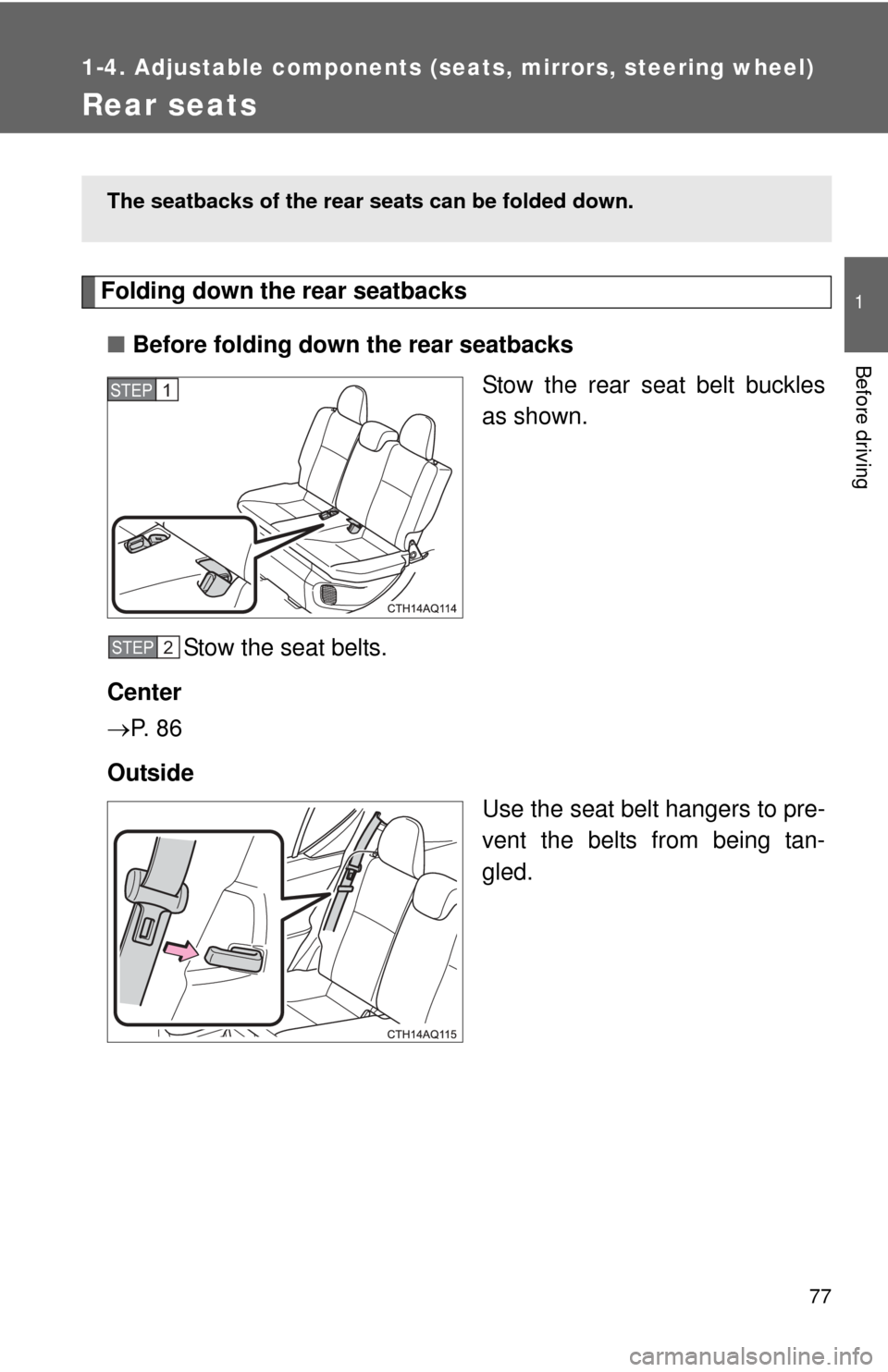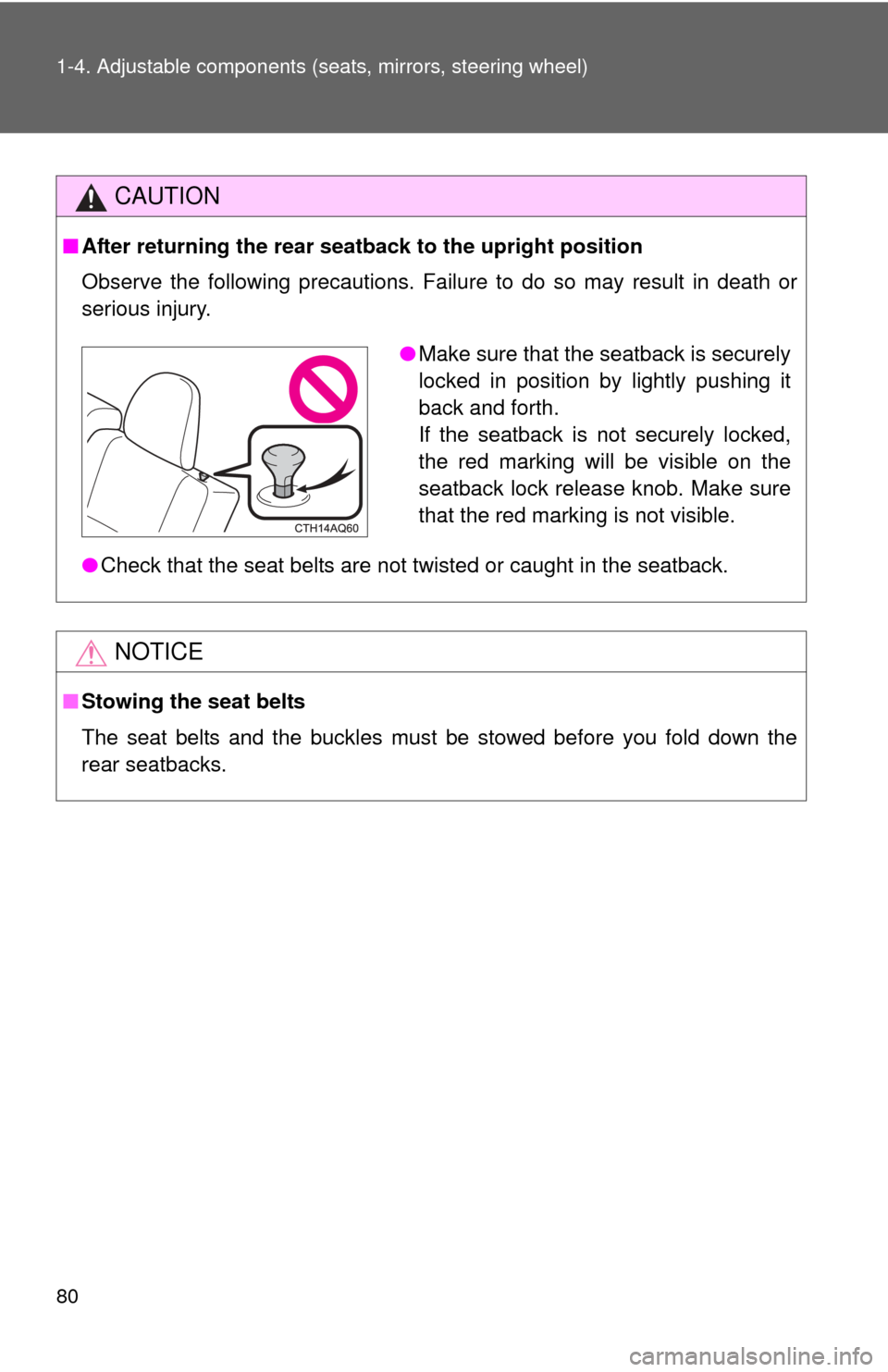2013 TOYOTA PRIUS C tow
[x] Cancel search: towPage 1 of 556

TABLE OF CONTENTS
1
1Before driving
Information on the hybrid system and adjusting and op-
erating features such as door locks, mirrors, and steer-
ing column.
2When drivingDriving, stopping and safe-driving information.
3Interior
featuresAir conditioning and audio systems, as well as other in-
terior features for a comfortable driving experience.
4Maintenance
and careCleaning and protecting your vehicle, performing do-it-
yourself maintenance, and maintenance information.
5When trouble
arisesWhat to do if the vehicle needs to be towed, gets a flat
tire, or is involved in an accident.
6Vehicle
specificationsDetailed vehicle information.
7For ownersReporting safety defects for U.S. owners, seat belt and
SRS airbag instructions for Canadian owners.
IndexAlphabetical listing of information contained in this
manual.
Page 3 of 556

1
2
3
4
5
6
7
3
2-2. Instrument clusterGauges and meters ............ 179
Indicators and warning lights ................................. 182
Multi-information display ..... 185
2-3. Operating the lights and wipers
Headlight switch .................. 202
Fog light switch ................... 206
Windshield wipers and washer .............................. 208
Rear window wiper and washer .............................. 212
2-4. Using other driving systems
Cruise control ...................... 215
Driving assist systems ........ 219
Hill-start assist control ......... 222
2-5. Driving information Cargo and luggage ............. 224
Vehicle load limits ............... 228
Winter driving tips ............... 229
Trailer towing ...................... 233
Dinghy towing ..................... 234 3-1. Using the air conditioning
system and defogger
Automatic air conditioning system .............................. 236
Rear window and outside rear view
mirror defoggers ............... 245
3-2. Using the audio system Audio system types ............ 246
Using the radio ................... 252
Using the CD player ........... 254
Playing back MP3 and WMA discs ....................... 259
Operating an iPod .............. 266
Operating a USB memory ............................ 274
Optimal use of the audio system .............................. 282
Using the AUX port............. 285
Using the steering wheel audio switches.................. 286
3-3. Using the Bluetooth
®
audio system
Bluetooth
® audio/phone ..... 289
Using the Bluetooth®
audio/phone ..................... 293
Operating a Bluetooth
®
enabled portable player.... 298
Making a phone call ........... 301
Using the “SET UP” menu (“Bluetooth” menu) ........... 306
Using the “SET UP” menu (“Phone” menu) ................ 312
3Interior features
Page 5 of 556

1
2
3
4
5
6
7
5
5-1. Essential informationEmergency flashers ............ 426
If your vehicle needs to be towed ................................ 427
If you think something is wrong ................................ 432
5-2. Steps to take in an emergency
If a warning light turns on or a warning buzzer
sounds .............................. 433
If a warning message is displayed........................... 443
If you have a flat tire............ 459
If the hybrid system will not start ............................. 471
If the shift lever cannot be shifted from P.................... 473
If you lose your keys ........... 474
If the electronic key does not operate properly.......... 475
If the vehicle 12-volt battery is discharged..................... 477
If your vehicle overheats ..... 482
If the vehicle becomes stuck ................................. 487
If your vehicle has to be stopped in an
emergency ........................ 488 6-1. Specifications
Maintenance data (fuel, oil level, etc.) ........... 492
Fuel information.................. 502
Tire information .................. 505
6-2. Customization Customizable features........ 518
Items to initialize ................. 524
Reporting safety defects for U.S. owners ................ 526
Seat belt instructions for Canadian owners
(in French) ........................ 527
SRS airbag instructions for Canadian owners
(in French) ........................ 529
Abbreviation list ........................ 540
Alphabetical index .................... 542
What to do if... .......................... 554
5When trouble arises6Vehicle specifications
7For owners
Index
Page 33 of 556

33
1-1. Hybrid system
1
Before driving
CAUTION
■
Road accident cautions
If your vehicle is involved in an accident, observe the following precautions
to reduce the risk of death or serious injury:
●Stop the vehicle in a safe place to prevent subsequent accidents, shift the
shift lever to P, apply the parking brake, and turn the hybrid system off.
( P. 148)
● Do not touch the high voltage parts, cables or connectors. Carefully check
to see if there are exposed high voltage parts or cables.
● If electric wires are exposed inside or outside your vehicle, an electric
shock may occur. Never touch exposed electric wires.
● If a fluid leak occurs, do not touch the fluid as it may be strong alkaline
electrolyte from the hybrid battery (traction battery). If it comes into contact
with your skin or eyes, wash it off immediately with a large amount of water
or, if possible, boric acid solution. Seek immediate medical attention.
● If a fire occurs in the hybrid vehicle, leave the vehicle as soon as possible.
Never use a fire extinguisher that is not meant for electric fires. Using even
a small amount of water may be dangerous.
● If your vehicle needs to be towed, do so with the front wheels raised. If the
wheels connected to the electric motor (traction motor) are on the ground
when towing, the motor may continue to generate electricity. This may
cause a fire. ( P. 427)
● Carefully inspect the ground under the vehicle. If you find that liquid has
leaked onto the ground, the fuel system may have been damaged. Leave
the vehicle as soon as possible and contact your Toyota dealer.
■ Nickel-metal hydride battery
Your vehicle contains a sealed nickel-metal hydride battery. If disposed of
improperly, it is hazardous to the environment and there is a risk of severe
burns and electrical shock that may result in death or serious injury.
Page 55 of 556

55
1-3. Opening, closing and locking the doors
1
Before driving
■
Conditions affecting operation
The smart key system uses weak radio waves. In the following situations,
the communication between the electronic key and the vehicle may be
affected, preventing the smart key system, wireless remote control and
immobilizer system from operating properly.
(Ways of coping: P. 475)
● When the electronic key battery is depleted
● Near a TV tower, electric power plant, gas station, radio station, large dis-
play, airport or other facility that generates strong radio waves or electri-
cal noise
● When the electronic key is in contact with, or is covered by the following
metallic objects
• Cards to which aluminum foil is attached
• Cigarette boxes that have aluminum foil inside
• Metallic wallets or bags
• Coins
• Hand warmers made of metal
• Media such as CDs and DVDs
● When other wireless keys (that emit radio waves) are being used nearby
● When carrying the electronic key together with the following devices that
emit radio waves
• A portable radio, cellular phone, cordless phone or other wireless com-
munication device
• Another vehicle’s electronic key or a wireless key that emits radio waves
• Personal computers or personal digital assistants (PDAs)
• Digital audio players
• Portable game systems
● If window tint with a metallic content or metallic objects are attached to
the rear window
● When the electronic key is placed near a battery charger or electronic
devices
Page 63 of 556

63
1-3. Opening, closing and locking the doors
1
Before driving
■
Conditions affecting operation
Vehicles without a smart key system
The wireless remote control function may not operate normally in the follow-
ing situations:
●When the wireless key battery is depleted
● Near a TV tower, electric power plant, gas station, radio station, large dis-
play, airport or other facility that generates strong radio waves or electri-
cal noise
● When carrying a portable radio, cell ular phone or other wireless commu-
nication device
● When the wireless key is in contact with, or is covered by a metallic
object
● When other wireless keys (that emits radio waves) are being used
nearby
● If window tint with a metallic content or metallic objects are attached to
the rear window
Vehicles with a smart key system
P. 5 5
■ If the wireless remote control does not operate properly (vehicles with
a smart key system)
Locking and unlocking the doors: Use the mechanical key.
( P. 475)
■ Key battery depletion
Vehicles without a smart key system
If the wireless remote control function does not operate, the battery may be
depleted. Replace the battery when necessary. ( P. 399)
Vehicles with a smart key system
P. 5 8
■ When the electronic key battery is fully depleted
P. 399
Page 77 of 556

77
1
1-4. Adjustable components (seats, mirrors, steering wheel)
Before driving
Rear seats
Folding down the rear seatbacks■ Before folding down the rear seatbacks
Stow the rear seat belt buckles
as shown.
Stow the seat belts.
Center
P. 8 6
Outside Use the seat belt hangers to pre-
vent the belts from being tan-
gled.
The seatbacks of the rear seats can be folded down.
STEP1
STEP2
Page 80 of 556

80 1-4. Adjustable components (seats, mirrors, steering wheel)
CAUTION
■After returning the rear seatback to the upright position
Observe the following precautions. Failure to do so may result in death or
serious injury.
●Check that the seat belts are not twisted or caught in the seatback.
NOTICE
■Stowing the seat belts
The seat belts and the buckles must be stowed before you fold down the
rear seatbacks.
●Make sure that the seatback is securely
locked in position by lightly pushing it
back and forth.
If the seatback is not securely locked,
the red marking will be visible on the
seatback lock release knob. Make sure
that the red marking is not visible.